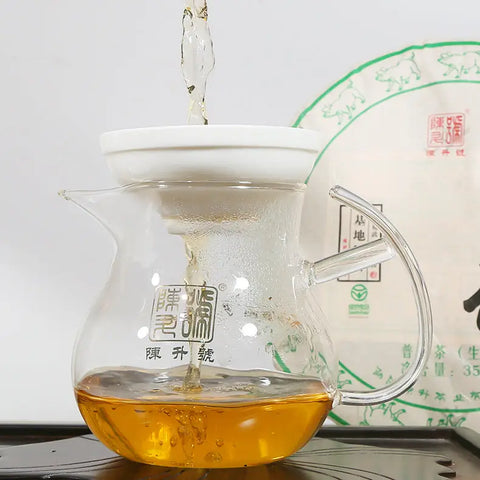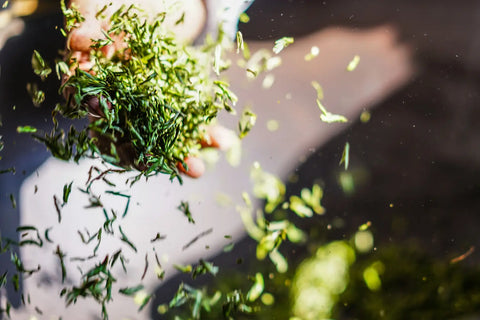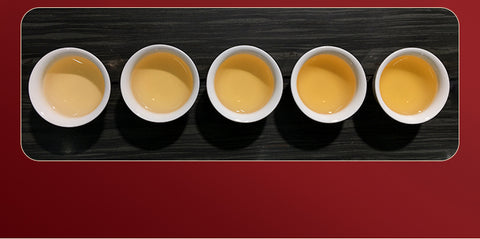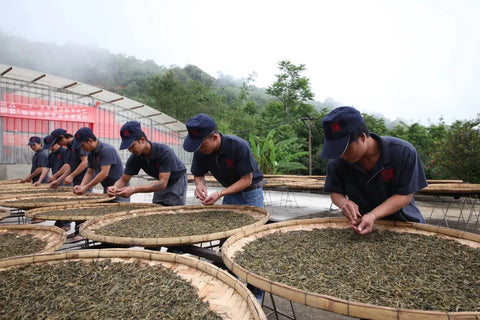How to Brew Pu Erh Tea
Shop our Pu Erh Tea collections!
Here are some quick steps to brew pu erh tea:
- Rinse tea leaves briefly with hot water
- Use 1-2 teaspoons of tea per cup
- Heat water to 95-100°C (203-212°F)
- Steep for 10-30 seconds (first infusion)
- Increase steeping time for subsequent infusions
- Can be brewed multiple times
- Adjust quantities and time to taste
But if you are still interested in knowing more about it, we must go back to its roots.
Bestsellers
Pu-erh tea has a rich history rooted in ancient traditions and boasts various unique types. Additionally, it offers distinct health benefits that distinguish it from other teas.
Origin and History
Pu-erh tea originates from Yunnan Province in China. It dates back over a thousand years to the Tang Dynasty. Pu-erh was traditionally used as a tribute tea for emperors. Its unique aging process and fermentation method were developed over centuries.
The tea is named after Pu'er City, which was a trading post for tea. It is known for its complex flavor, which evolves over time due to the fermentation process. Yunnan Province's climate and soil contribute to its unique characteristics.
Types of Pu-erh Tea
There are two main types of Pu-erh tea: Sheng (raw) and Shou (ripe).
Sheng Pu-erh undergoes a natural fermentation process and can age for many years. It's known for its vibrant flavor profile.
Shou Pu-erh undergoes an accelerated fermentation process, making it darker and richer. This process was developed in the 1970s to meet market demand.
Both types offer unique flavor experiences, ranging from earthy and sweet to bitter and complex. The aging process influences the taste and aroma, making each batch unique.
Discover our best-selling raw Pu Erh tea and elevate your tea experience today!
Health Benefits
Pu-erh tea is known for various health benefits. It can aid in digestion, making it a popular choice after meals. The tea also contains antioxidants that help protect cells from damage.
Research suggests that Pu-erh may help in maintaining cholesterol levels and supporting weight loss. Regular consumption can contribute to cardiovascular health. It also contains anti-inflammatory properties.
While more studies are needed, many enthusiasts drink Pu-erh for its purported benefits on overall well-being. It provides a unique combination of aged flavors and potential health advantages.
Essential Brewing Equipment

Lao Ban Zhang
To brew Pu Erh tea effectively, you need the right tea ware and suitable water to attain the best flavor and aroma.
Tea Ware Selection
Selecting appropriate tea ware is crucial for brewing Pu Erh tea. Yixing clay teapots are highly recommended due to their ability to retain heat and enhance the tea's flavor over time.
Alternatively, you can use a Gaiwan—a traditional Chinese lidded bowl, which is ideal for quick infusions. Glass or ceramic teapots are also suitable, especially for beginners.
An infusion pitcher for separating leaves from the brew, and small tea cups to appreciate the tea’s color and aroma, are also essential. Lastly, a tea tray helps manage spills and maintain a clean brewing space.
Choosing the Right Water
Water quality affects the final taste of Pu Erh tea significantly. Use filtered or spring water to avoid impurities and chemical tastes from tap water.
Water temperature is also vital; aim for boiling water to extract the tea's full-bodied flavor. Soft water is preferable over hard water, as it allows the tea’s subtle nuances to come through.
Additionally, preheat your tea ware by rinsing with hot water to ensure an even temperature throughout the brewing process. Always use fresh water for each batch to maintain the tea's purity.
Preparing the Tea Leaves

To brew pu-erh tea properly, it is crucial to measure the correct amount of tea leaves and perform a rinsing step. This ensures the best flavor and helps release the natural essence of the leaves.
Measuring the Correct Amount
When measuring pu-erh tea leaves, you typically need about 5-7 grams per 200 ml of water. Use a digital kitchen scale to measure accurately. Keep in mind that different types of pu-erh tea, such as raw (sheng) and ripe (shou), might require slight adjustments in the quantity.
If you're brewing for multiple people, multiply the amount accordingly. The correct measurement can significantly affect the overall taste and strength of your tea. Too many leaves might result in a bitter brew, while too few can make it watery and weak.
Rinsing Pu-erh Tea
Rinsing pu-erh tea helps to awaken the leaves and remove any impurities. Start by placing the measured tea leaves in your teapot or gaiwan. Pour hot water over the leaves, ensuring they are fully submerged, and let it sit for 5-10 seconds.
Immediately pour out the water, discarding the rinse. This simple step not only cleans the leaves but also primes them for the brewing process. For compressed pu-erh, like cakes or bricks, a rinse helps to loosen the leaves and release their complex flavors more effectively. Don’t skip this step for the best tasting pu-erh tea.
The Brewing Process
Brewing pu erh tea requires precision and a good understanding of water temperature, steeping time, and the techniques for multiple infusions. This ensures that you extract the best flavors and benefits from the tea leaves.
Water Temperature Guidelines
For pu erh tea, using the correct water temperature is crucial. Generally, you should use water heated to around 200°F (93°C). This temperature is ideal for releasing the complex flavors without over-extracting and creating bitterness.
When brewing aged pu erh, slightly cooler water, around 190°F (88°C), can be used to avoid extracting harsh flavors. Conversely, young sheng pu erh can handle slightly hotter water, up to 205°F (96°C), which helps in breaking down the leaves more effectively.
Steeping Time and Techniques
Steeping time for pu erh tea varies depending on personal preference and the type of tea. A typical first infusion usually lasts 20-30 seconds. Subsequent infusions can be slightly longer, gradually increasing the time by 10-20 seconds.
Rinse the leaves with hot water for about 5 seconds before the first infusion to awaken the flavors. Use a gaiwan or yixing teapot for better control over the steeping process. Always cover the tea completely with water and ensure even brewing.
Sequential Infusions
Pu erh tea is known for its ability to be infused multiple times. Typically, you can get 5-10 good infusions from quality pu erh leaves.
For each subsequent infusion, gradually increase the steeping time. The first infusion might be for 20 seconds, the second for 30 seconds, and so on. Adjust based on taste preferences. This method allows the flavors to evolve and unfold with each infusion, providing a unique experience with every cup.
By following these guidelines, you will be able to enjoy the full, rich flavors that pu erh tea offers.
Serving and Enjoying Pu-erh Tea

Serving Pu-erh tea often blends cultural rituals with sensory enjoyment. Understanding both ceremonial aspects and tasting notes greatly enhances the experience of savoring this unique tea.
Ceremonial Aspects
Serving Pu-erh tea can involve traditional ceremonies, which vary based on cultural backgrounds. In Chinese culture, a Gongfu tea ceremony is commonly practiced. This involves a series of precise steps, including rinsing the tea leaves, warming the teapot, and multiple short steeps.
To perform a Gongfu ceremony, start by using a small teapot and serving cups. Rinse the tea leaves and all utensils with hot water.
Next, add the tea leaves to the teapot and pour hot water to steep for 10-20 seconds. Discard the first infusion to "wake up" the leaves.
Following this, steep the tea multiple times, each for slightly longer. Each infusion will reveal different flavors, allowing you to appreciate the complex profile of the tea.
Tasting Notes and Aroma
Pu-erh tea is known for its depth and complexity in flavor and aroma. Younger, raw Pu-erh tends to have a fresh and earthy taste with a hint of floral notes.
Aged Pu-erh often develops rich, earthy flavors with hints of mushroom, wood, or leather.
When tasting, pay close attention to the texture of the tea, which can range from smooth and silky to robust and full-bodied.
The aroma can also provide clues about the tea's age and quality. Smell the wet leaves after the first infusion; younger Pu-erh may have a vegetal scent, while older Pu-erh often exudes a more mature, earthy fragrance.
Experimenting with different infusions helps unlock the full spectrum of flavors and aromas unique to Pu-erh tea.
Storage and Aging

Proper storage is crucial for ensuring the quality and longevity of pu erh tea. Aging can enhance flavors but requires attention to detail.
Optimal Conditions
Pu erh tea thrives in a dry, well-ventilated environment. Humidity levels should ideally be between 60-70%.
Temperature should stay consistent, preferably between 20-25°C (68-77°F). Avoid direct sunlight, which can degrade the tea's quality. Place the tea in breathable materials like paper or cloth to allow air circulation. Aim for minimal odor exposure; avoid storing near strong-smelling items.
Using a dedicated storage container or area can greatly improve aging conditions. Containers with slight ventilation are preferable.
Common Storage Mistakes
High humidity can cause mold growth. Monitor the storage area regularly to keep humidity within safe levels.
Temperature fluctuations can negatively impact the tea. Ensure the storage spot maintains a stable temperature.
Sealing in plastic or airtight containers can trap moisture, leading to spoilage. Always use breathable materials for storage.
Storing pu erh near aromatic substances can lead to flavor contamination. Choose a clean, odor-free environment.
Avoid the temptation to handle the tea frequently; excessive handling can alter its aging process. Minimizing direct contact helps preserve the tea's integrity.
← Older post Newer post →











